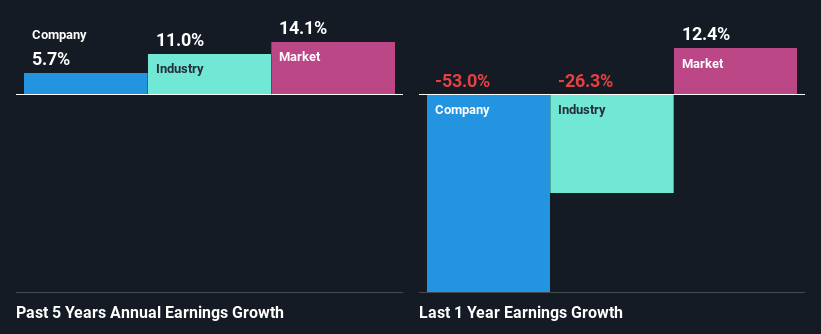- Malaysia
- /
- Semiconductors
- /
- KLSE:UNISEM
Unisem (M) Berhad's (KLSE:UNISEM) Fundamentals Look Pretty Strong: Could The Market Be Wrong About The Stock?
With its stock down 27% over the past three months, it is easy to disregard Unisem (M) Berhad (KLSE:UNISEM). However, the company's fundamentals look pretty decent, and long-term financials are usually aligned with future market price movements. Specifically, we decided to study Unisem (M) Berhad's ROE in this article.
ROE or return on equity is a useful tool to assess how effectively a company can generate returns on the investment it received from its shareholders. Simply put, it is used to assess the profitability of a company in relation to its equity capital.
See our latest analysis for Unisem (M) Berhad
How To Calculate Return On Equity?
The formula for ROE is:
Return on Equity = Net Profit (from continuing operations) ÷ Shareholders' Equity
So, based on the above formula, the ROE for Unisem (M) Berhad is:
3.1% = RM73m ÷ RM2.4b (Based on the trailing twelve months to June 2024).
The 'return' is the profit over the last twelve months. So, this means that for every MYR1 of its shareholder's investments, the company generates a profit of MYR0.03.
What Has ROE Got To Do With Earnings Growth?
We have already established that ROE serves as an efficient profit-generating gauge for a company's future earnings. Depending on how much of these profits the company reinvests or "retains", and how effectively it does so, we are then able to assess a company’s earnings growth potential. Assuming everything else remains unchanged, the higher the ROE and profit retention, the higher the growth rate of a company compared to companies that don't necessarily bear these characteristics.
A Side By Side comparison of Unisem (M) Berhad's Earnings Growth And 3.1% ROE
It is quite clear that Unisem (M) Berhad's ROE is rather low. Not just that, even compared to the industry average of 7.2%, the company's ROE is entirely unremarkable. However, the moderate 5.7% net income growth seen by Unisem (M) Berhad over the past five years is definitely a positive. Therefore, the growth in earnings could probably have been caused by other variables. For instance, the company has a low payout ratio or is being managed efficiently.
Next, on comparing with the industry net income growth, we found that Unisem (M) Berhad's reported growth was lower than the industry growth of 11% over the last few years, which is not something we like to see.

Earnings growth is an important metric to consider when valuing a stock. What investors need to determine next is if the expected earnings growth, or the lack of it, is already built into the share price. Doing so will help them establish if the stock's future looks promising or ominous. Is Unisem (M) Berhad fairly valued compared to other companies? These 3 valuation measures might help you decide.
Is Unisem (M) Berhad Making Efficient Use Of Its Profits?
With a three-year median payout ratio of 44% (implying that the company retains 56% of its profits), it seems that Unisem (M) Berhad is reinvesting efficiently in a way that it sees respectable amount growth in its earnings and pays a dividend that's well covered.
Besides, Unisem (M) Berhad has been paying dividends for at least ten years or more. This shows that the company is committed to sharing profits with its shareholders. Looking at the current analyst consensus data, we can see that the company's future payout ratio is expected to rise to 59% over the next three years. Regardless, the future ROE for Unisem (M) Berhad is speculated to rise to 7.3% despite the anticipated increase in the payout ratio. There could probably be other factors that could be driving the future growth in the ROE.
Summary
In total, it does look like Unisem (M) Berhad has some positive aspects to its business. Specifically, its fairly high earnings growth number, which no doubt was backed by the company's high earnings retention. Still, the low ROE means that all that reinvestment is not reaping a lot of benefit to the investors. Having said that, looking at the current analyst estimates, we found that the company's earnings are expected to gain momentum. Are these analysts expectations based on the broad expectations for the industry, or on the company's fundamentals? Click here to be taken to our analyst's forecasts page for the company.
New: AI Stock Screener & Alerts
Our new AI Stock Screener scans the market every day to uncover opportunities.
• Dividend Powerhouses (3%+ Yield)
• Undervalued Small Caps with Insider Buying
• High growth Tech and AI Companies
Or build your own from over 50 metrics.
Have feedback on this article? Concerned about the content? Get in touch with us directly. Alternatively, email editorial-team (at) simplywallst.com.
This article by Simply Wall St is general in nature. We provide commentary based on historical data and analyst forecasts only using an unbiased methodology and our articles are not intended to be financial advice. It does not constitute a recommendation to buy or sell any stock, and does not take account of your objectives, or your financial situation. We aim to bring you long-term focused analysis driven by fundamental data. Note that our analysis may not factor in the latest price-sensitive company announcements or qualitative material. Simply Wall St has no position in any stocks mentioned.
About KLSE:UNISEM
Unisem (M) Berhad
Provides semiconductor assembly and test services for electronic companies in Asia, Europe, and the United States.
Reasonable growth potential with adequate balance sheet.
Similar Companies
Market Insights
Community Narratives



